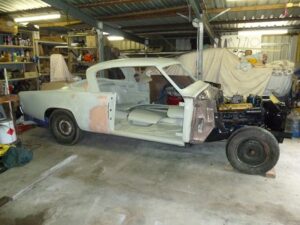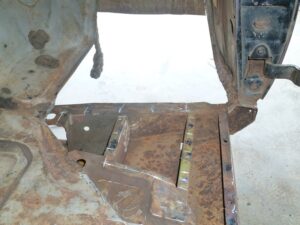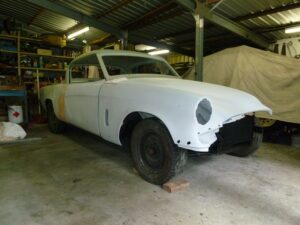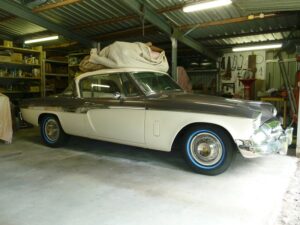1955 Speedster – Jim Dack – SCCQ
I was introduced to Studebakers by a work colleague when I was doing my apprenticeship as a fitter and turner.
In 1973 at the age of eighteen I purchased a 1964 Cruiser, unfortunately this car was written off less than a year later when I was T boned at an intersection. I replaced the Cruiser with a 1963 two door Lark that I purchased as a rolling chassis. This car was an ex police car from Victoria. I transferred all the running gear from my Cruiser to the Lark. Between the years 1976 to 1978 this car was used extensively for drag racing as well as my road car.
A process of continuous improvement meant that I became well versed in getting the best performance out of the Studebaker V8. The two door was fitted with a 5.4 ratio differential and a wide ratio top loader gearbox. The car was competitive on the track and proved to be dependable providing 7,500 rpm was not exceeded. Typical launch revs and gear changes were within the 6,500 – 7,500 rev range.
I purchased a barn find 1965 Cruiser with the Chevrolet engine from John Venema in 1982. After recommissioning this car was a reliable family car for the next nine years. I was looking for a project car in 2007 and found an advertisement for the Speedster which had been put up for sale by Bob Clark of Victoria. By chance when browsing through a Just Cars magazine in the workshop crib room.
A Speedster was a worthwhile project even though the condition of the car would ensure that it was a major project requiring a nut and bolt restoration. A top of the line Studebaker product that had seen only a little over two thousand cars built this car appealed to me as the only extensive restoration project that I am likely to undertake. My 1955 Speedster was a Californian car that was ordered on the 16/12/1954 and completed final assembly on the 30/12/1954.

Body number 177 and serial number 7805763.
The original owner of the car was shot dead in the car in Lennox California in 1989. I have saved the right hand rear side glass complete with two bullet holes as a memento of the car’s history. The car was sold on the18/10/1989 and again on the 07/11/1989 when it went to an Arizona purchaser. On the23/05/1998 the car returned to California to a new owner.
Judging by the poor condition of the car when I purchased it, I do not believe that any of these owners actually drove the car. I purchased the car on the 13/08/2007. The car was registered in Queensland on the 07/08/2014.

When I received the car, it was overall in a very poor state and the engine was seized. However, it was almost complete, and was pretty straight in the body. Rust repairs required the replacement of the front floor plates and door sills. The front and rear mudguards on the Left hand side required repair panels to be welded in. The chassis also required repair.
My work as a heavy equipment diesel fitter provided me with access to well equipped workshops where I could work in my own time on the car. These facilities were not available to me in my own garage. Had I waited until my retirement to complete this project the work would have been much more difficult and time consuming.
It was my intention to do as much as possible of the restoration work myself. The more work that I could do myself the more satisfaction that I would feel in the completed project. I progressively disassembled the car and restored all the parts as I went along. When it came to rebuilding the engine, I applied the experience I had earlier gained with Studebaker V8’s. I wanted a car with better highway driving characteristics than was available from the standard 259 Cubic inch motor.

I installed a camshaft of my own specification, and the heads were ported and polished. Roller lifters and heavy duty valve springs were fitted. I switched from the original carburettor to a Holley 600 4160 that uses a vacuum secondary system. It worked straight out of the box and has been a very good option for not a lot of money.
I also fitted an engine oil cooler. I rebuilt the automatic gearbox and the differential. I sent all the gauges out to Otto Instruments here in Brisbane for refurbishment and I was happy with the outcome. When stripping the car, I confirmed that the original paint work was Pimlico Gray and Congo Ivory. I prepared the car for painting and painted it in my home garage. The result was very satisfactory from my perspective and well worth the time and effort.
Repairing the chrome and stainless was a major expense and involved a lot of time and effort. I polished all the stainless myself. The drip rail mouldings had a lot of tiny dents that required a lot of work to remove before polishing. All of the chrome required redoing. Finding a good chrome plater and dealing with him involved many trips to his premises and some difficult discussions before the work was completed.
The pot metal parts were severely pitted prior to chrome plating and as expected the result was less than perfect. However, given the material and the condition of these parts the result was probably the best that could be hoped for. The front bumper had to be redone a couple of years later as blisters developed in the chrome.
Shortly after starting the restoration, I ordered an interior kit from Phantom Autoworks in the US. The kit was not cheap but worth it in for the quality provided. I fitted this kit myself. All this aside, the kit sat in large boxes in the shed for two years before my wife noticed their presence. As this kit was the largest single purchase for the restoration this delay in learning of the cost softened the impact somewhat of the high cost of the purchase.
As an active member of the SCCQ the Speedster gets out and about on a regular basis. The money, time and effort have been well worthwhile.
|

